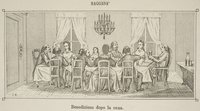
Curated by Pesach Weinstein, Ph.D. Candidate, Divinity School
The week-long, springtime Jewish holiday of Pesach, or Passover, is beloved for its symbolic meaning and joyous customs. Passover marks the freeing of the Israelites from slavery in Egypt, a narrative with universal appeal as a paradigm for collective and, according to some traditions, personal liberation. The Haggadah (plural: Haggadot), or “telling,” is the collection of prayers, legends, and stories recited on the eve of Passover.
The basic text of the Haggadah derives from the biblical instruction to retell the story of the Exodus each year during Passover in conjunction with a ritual meal called the Seder, or “order” (Exodus 13:8). Over the centuries songs and illustrations have been added to engage children, to whom the story was to be told, and some passages are given added prominence when they resonate with contemporary concerns. Illustrations in medieval manuscripts depict scenes from Exodus, the life of Moses, and Jewish Patriarchs. Many of these scenes continue to appear in early printed Haggadot, but the emphasis shifts to passages drawn directly from the text. The Haggadah has shown remarkable stability and flexibility: thousands of editions in all languages testify to its central role in Jewish life and its ability to incorporate new themes and respond to changing conditions.
This exhibition is drawn entirely from the private collection of Stephen P. Durchslag, the largest known collection of Haggadot in private hands. “Archetype and Adaptation” explores the enduring influence of early printed Haggadot as well as the ability of modern versions to reflect political and social developments such as the Holocaust, Zionism, gay rights, and feminism. The Haggadah embodies the adaptive genius of Jewish practice and the consequent vitality of Jewish life. Items selected for the exhibition exemplify early Haggadah archetypes and later adaptations, framed by facsimiles of medieval manuscripts and modern Haggadot illustrated by noted artists.
Illustrations were often copied and pirated in early printed books. Images were expensive to produce, so woodcuts were reused until they wore out and copper plates made long journeys from one city to another. During the sixteenth and seventeenth centuries, several Haggadot became models for countless later editions. Yosef Yerushalmi has identified four early printed editions that served as “archetypes”: Prague (1526), Mantua (1560), Venice (1609), and Amsterdam (1695). Each of these was shaped by the artistic culture and printing trades of the city in which it was produced—for example, Renaissance Italian borders and architectural frames appear in Venice, copperplate engraving is used instead of woodcut in Amsterdam—and introduced iconography that can be seen in Haggadot produced hundreds of years later. The exhibition traces the movement of these models across continents and time, demonstrating the enduring appeal of the Haggadah story and the infinite variety of interpretation and adaptation it inspires.